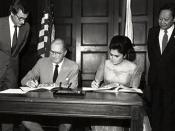The Malcolm Baldrige National Quality Award was created by Congress in 1987. According to the article, the award was established to "recognize U.S. organizations for their achievements in quality and business performance, and to raise awareness about the importance of quality and performance excellence as a competitive edge." The award created a benchmark that U.S. companies could try and reach in order to achieve world-class quality.
The Baldrige award is comprised of a framework of seven categories:
(1) Leadership
(2) Strategic planning
(3) Customer and market focus
(4) Information and analysis
(5) Human resource focus
(6) Process management
(7) Business results
This framework "has now matured into a well-developed profit-improvement model." The leadership triad (categories 1,2 and 3) are placed together to emphasize the focus on strategy and customers. The results triad (categories 5,6 and 7) are placed together because an "organization's employees and its key processes accomplish the work of the organization that yields its business results."
Figure 1 in the article shows this framework from a systems perspective.
I think the main theme of this article is describing how The Baldrige Award is designed and the ways that it has evolved thru the years. For someone like myself, who has limited knowledge of this Award, the article is very informative. The award process is explained in an easy to understand manner. Vokurka writes that the award has gone beyond quality improvement to a model for overall organizational performance improvement: It has helped American business succeed. And judging from this last statement, I think that the author is biased in the presentation of the article. Vokurka clearly believes in the benefits of the Baldrige Award. And after reading the article, I would tend to agree with him. The award criteria does create benchmarks and promote Total Quality Management for...


